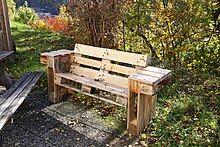Upcycling
When Upcycling ( English up "up" and recycling "recycling") are waste products converted or (seemingly) useless substances as new products. In contrast to downcycling , this form of recycling results in a material upgrade. The recycling or reuse of existing material reduces the use of raw materials .
The term was mentioned early in 1994 in an article in the British magazine Salvo , in which the engineer Reiner Pilz from Burgdorfer Pilz GmbH is quoted with his criticism of the Waste Framework Directive and the practice of building material recycling:
'Recycling', he said, 'I call it down-cycling. They smash bricks, they smash everything. What we need is up-cycling where old products are given more value, not less. '
“'Recycling,' he said, I call it down-cycling. They break stones, they break everything. What we need is up-cycling, where old products get a higher value, not a lower value. '"
Due to the dwindling natural resources and social change, upcycling is gaining in importance, and cost savings and new marketing opportunities are further advantages. The German Federal Environment Agency assigned upcycling in the sense of reuse of materials a rank as an innovation type in 2016 :
- In the case of "re-use" - for example in the context of upcycling, the use of leftover production for art projects or the collection of windfalls - on the other hand, products withdrawn from consumption are returned to the market and thus regain their value.
In "poor" societies Upcycling is applied disproportionately common: In many developing countries such. B. braiding techniques are widespread, with which new products can be made from old rubber and plastic products; so will u. A. from old car tires soles for flip-flops .
But upcycling is also on the advance in “wealthy” or “ throwaway societies ”: Some companies are trying to replace conventional materials with creative misappropriation of unconventional resources. For example, sunglasses are made from old books and broken jeans or cups are made from coffee grounds. In addition, aesthetic aspects are gaining in importance; some people use e.g. B. mostly old fruit crates, pallets , wine bottles or pipes to create new products for interior and exterior decoration. The increasing popularity in the fashion sector is mainly due to the individuality of the products created through upcycling.
So z. B. from nylon tights hair ties, tetrapaks become lanterns and empty screw jars become flower vases.
Use of the term
The term "upcycling" is also used in business. In an interview with Deutsche Wirtschaftsnachrichten Magazin, RWTH Aachen professor Ulrich Krupp used the term "upcycling" in connection with the reprocessing of steel scrap.
The mining Brixlegg Aktiengesellschaft , a company of secondary copper production from Brixlegg , Austria , used the term in connection with the registered of them word mark "Upcycling Copper".
Web links
- Upcycling against consumerism in Europe , Tagesschau , "Club28" from May 24, 2019
Individual evidence
- ^ Thornton Kay: Salvo in Germany ( Memento from July 15, 2011 in the Internet Archive ) . Salvo Monthly No. October 23, 1994, pp. 11-14 (quote: p. 14), accessed November 3, 2012.
- ^ Thornton Kay: Salvo in Germany ( Memento from July 15, 2011 in the Internet Archive ) . Salvo Monthly No. October 23, 1994, p. 14.
- ↑ Belinda Goldsmith: Trash or treasure? Upcycling becomes a growing green trend . Reuters, September 30, 2009, accessed November 3, 2012.
- ^ "Making environmental policy fit for the transformation: New basic configurations for an applied environmental policy", Federal Environment Agency 2016, p. 12. Accessed April 30, 2020 .
- ↑ Upcycling: This garbage looks good on you . In: ZEITmagazin . ( zeit.de [accessed on October 16, 2018]).
- ↑ Recycling: Is this fashion or can it go away? In: ZEIT Campus . ( zeit.de [accessed on October 16, 2018]).
- ↑ Mari says: Make Zero Waste DIY hair ties yourself. In: Uponmylife. March 24, 2020, accessed on April 19, 2020 (German).
- ↑ Upcycling idea: lantern made from tetra packs. In: Uponmylife. January 8, 2020, accessed on April 19, 2020 (German).
- ↑ 19 Upcycling DIY ideas for empty screw-top jars. In: Uponmylife. March 12, 2020, accessed on April 19, 2020 (German).
- ↑ Hauke Rudolph: Stahl: Swan song on a German myth? Deutsche Wirtschaftsnachrichten, June 27, 2020, accessed on June 28, 2020 (German).
- ^ Montanwerke Brixlegg: Upcycling - Montanwerke Brixlegg AG. Retrieved June 28, 2020 .
